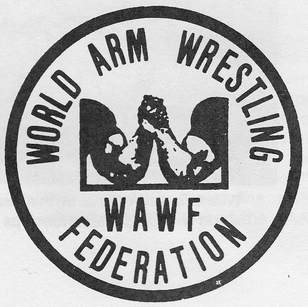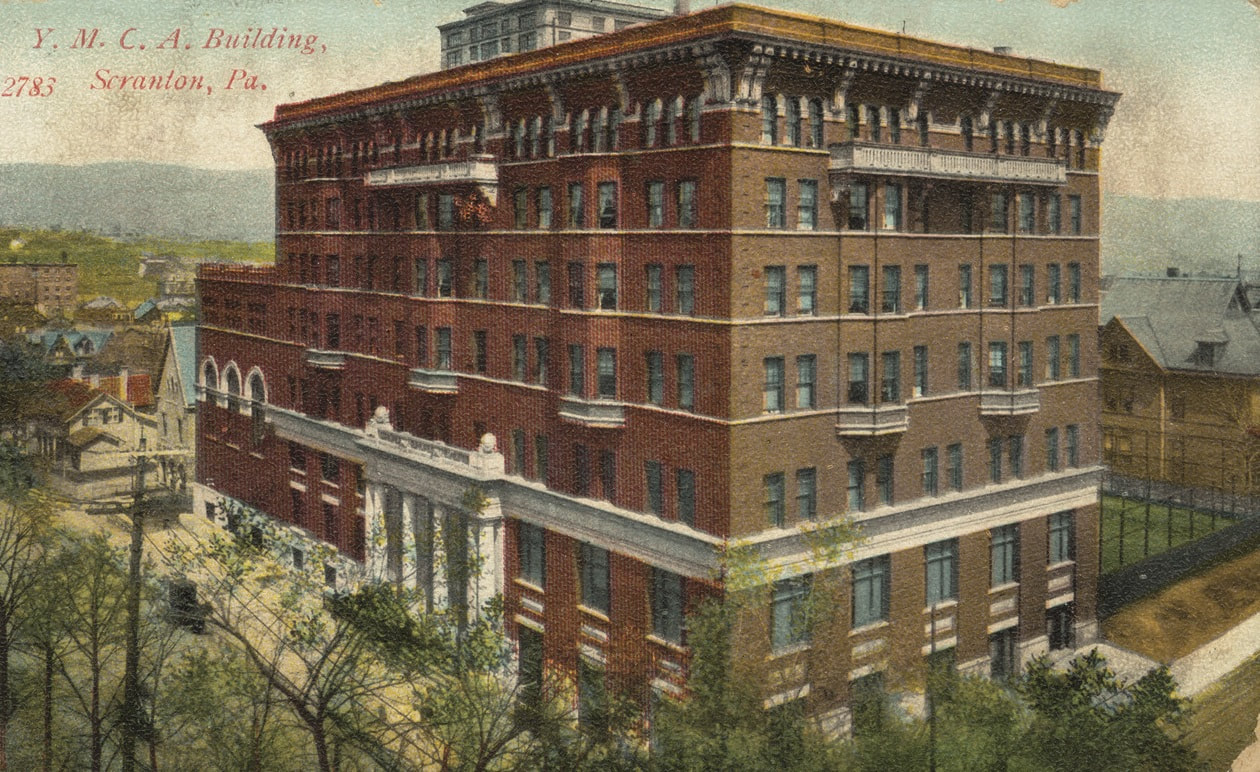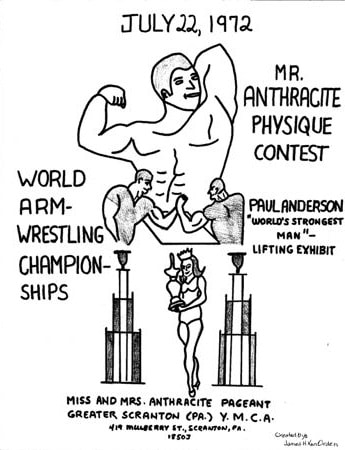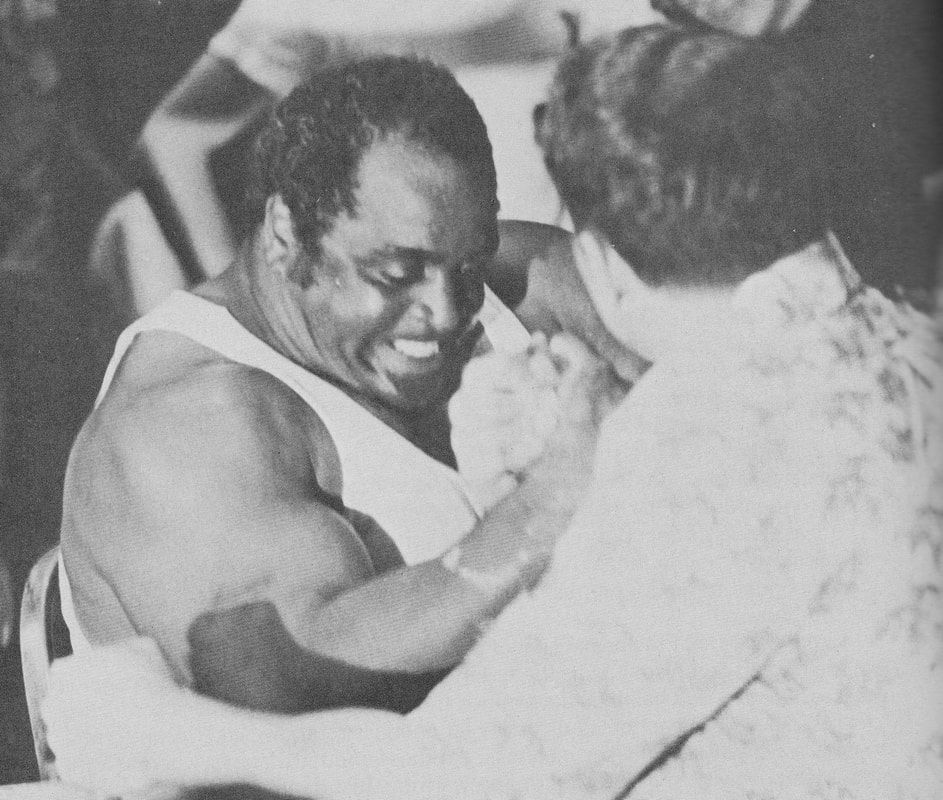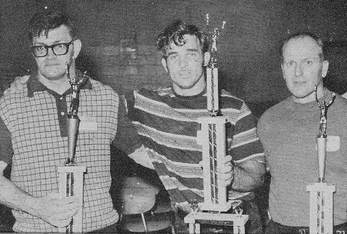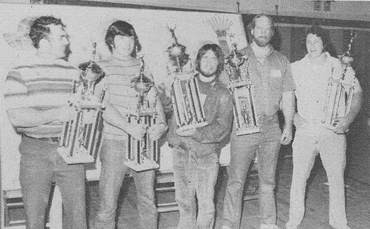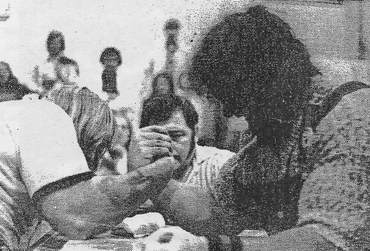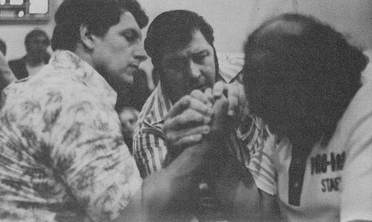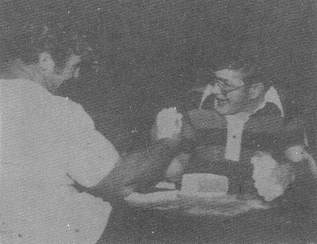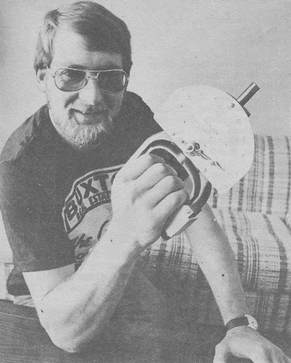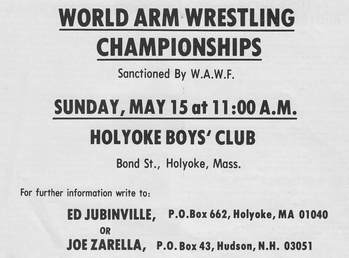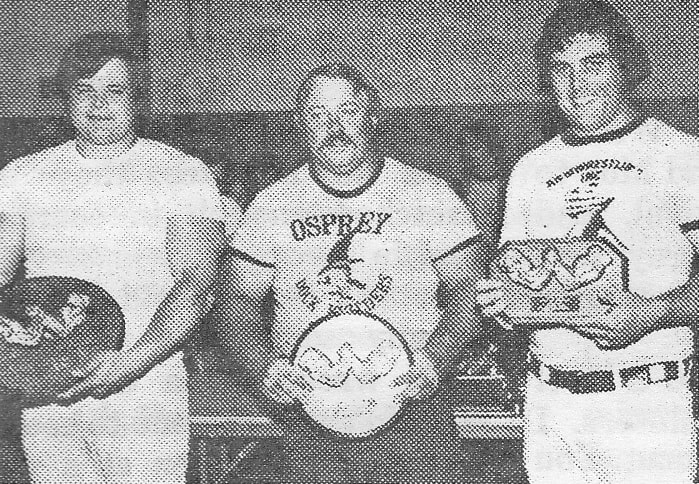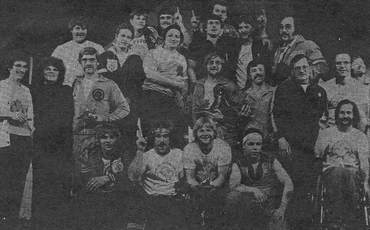The Origins of the World Armwrestling Federation
In the span of 40 years, the World Armwrestling Federation (WAF; previously known as the World Arm Wrestling Federation – WAWF) has grown from an organization with a single member country to one that is 80-plus member countries strong. On April 20, 2018 its efforts were rewarded with the sport of armwrestling being granted full membership status with the Global Association of International Sports Federations (GAISF), an umbrella organisation for all international sports federations. This is quite an accomplishment – fewer than 100 sports have this status – and it is an important stepping stone to getting armwrestling recognized by national governments and the sponsorship possibilities that can come from said recognition. Every organization has to start somewhere: this is the story of how the WAF first began taking shape.
In the late 1950s, a young man from Scranton, Pennsylvania, by the name of Robert O’Leary was in the navy. During this time, he was exposed to an activity that sailors liked to do to pass the time – challenge each other to armwrestling matches. Though not the best at it, he found the activity to be a good test of strength as well as entertaining.
After leaving the navy, Bob got into the banking business, but within a few years he decided to move into an industry that was more in line with his passion with physical culture: sports nutrition. He formed one of the very first sports nutrition distribution companies in the U.S. He also decided to start hosting physique contests (bodybuilding), powerlifting meets, and eventually by 1970, armwrestling tournaments.
All of the contests that Bob organized in these early days were held at, and for the benefit of, the Scranton YMCA – the YMCA being an organization whose mission the young O’Leary very much supported. The first armwrestling tournaments featured local talent – most of the competitors were from the Scranton area. The matches were contested seating, using a regular wooden table (approximately 2’ wide by 4’ long) and a couple of chairs. A wristwrestling grip was used (i.e. with non-competing hands clasped in the middle). There was a marked off area where competitors had to place their elbows, but there were no elbow or pin pads.
After leaving the navy, Bob got into the banking business, but within a few years he decided to move into an industry that was more in line with his passion with physical culture: sports nutrition. He formed one of the very first sports nutrition distribution companies in the U.S. He also decided to start hosting physique contests (bodybuilding), powerlifting meets, and eventually by 1970, armwrestling tournaments.
All of the contests that Bob organized in these early days were held at, and for the benefit of, the Scranton YMCA – the YMCA being an organization whose mission the young O’Leary very much supported. The first armwrestling tournaments featured local talent – most of the competitors were from the Scranton area. The matches were contested seating, using a regular wooden table (approximately 2’ wide by 4’ long) and a couple of chairs. A wristwrestling grip was used (i.e. with non-competing hands clasped in the middle). There was a marked off area where competitors had to place their elbows, but there were no elbow or pin pads.
Mr. O’Leary was one of the first, but not the only person who was running armwrestling tournaments at the time. At a bodybuilding show in York, Pennsylvania, Bob first met Ed Jubinville from Massachusetts. Ed owned a weightlifting equipment manufacturing company, and Bob was one of his customers. Bob quickly discovered that Ed too was interested in armwrestling. He had actually been holding annual events at the Mountain Park amusement park in Holyoke since 1958! They decided to stay in touch and help promote each other’s tournaments. It was the start of what would become a lifelong friendship.
Some of the first official contests that Bob witnessed were the annual World Arm Wrestling Championships tournaments organized by the International Federation of Arm Wrestlers (IFAW). These contests were held in conjunction with the Mr. Olympia bodybuilding contests held in New York City between 1967 and 1970. These tournaments had a greater reach due to their promotion in Joe Weider’s muscle magazines, and some competitors travelled long distances to compete. Bob met many talented pullers there, and he used the opportunity to spread the word about his tournaments in Scranton.
Word of the Scranton tournaments also made its way to bodybuilding legend John Grimek, who was the editor of Muscular Development at the time. John was a fan of the arm game, and had actually established a rudimentary set of contest rules around 1961 while working in York, Pennsylvania, writing articles for Strength and Health magazine. (His rules required that non-competing be placed behind the back.) By the early 1970s John had noticed an increase in reader inquiries about armwrestling, and so he decided to start researching an article on armwrestling rules. As part of this research he sent a letter to Mr. O’Leary requesting information on the rules he used for the Scranton tournaments. Mr. Grimek contacted a handful of other armwrestling promoters – most of whom were also bodybuilding and/or powerlifting promoters who had recently begun adding armwrestling contests to their programs.
Some of the first official contests that Bob witnessed were the annual World Arm Wrestling Championships tournaments organized by the International Federation of Arm Wrestlers (IFAW). These contests were held in conjunction with the Mr. Olympia bodybuilding contests held in New York City between 1967 and 1970. These tournaments had a greater reach due to their promotion in Joe Weider’s muscle magazines, and some competitors travelled long distances to compete. Bob met many talented pullers there, and he used the opportunity to spread the word about his tournaments in Scranton.
Word of the Scranton tournaments also made its way to bodybuilding legend John Grimek, who was the editor of Muscular Development at the time. John was a fan of the arm game, and had actually established a rudimentary set of contest rules around 1961 while working in York, Pennsylvania, writing articles for Strength and Health magazine. (His rules required that non-competing be placed behind the back.) By the early 1970s John had noticed an increase in reader inquiries about armwrestling, and so he decided to start researching an article on armwrestling rules. As part of this research he sent a letter to Mr. O’Leary requesting information on the rules he used for the Scranton tournaments. Mr. Grimek contacted a handful of other armwrestling promoters – most of whom were also bodybuilding and/or powerlifting promoters who had recently begun adding armwrestling contests to their programs.
Bob followed up his detailed response with a call to John, during which he asked if Muscular Development would be open to announcing upcoming armwrestling contests and publishing tournament results. There was a bit of resistance at first, but eventually regular coverage was provided.
The year 1971 saw Mr. O’Leary organize his biggest tournament to date: the North American Arm Wrestling Championships. (This contest would later be referred to as the first Scranton World Arm Wrestling Championships.) The timing seemed right for a big event. By this time, coverage of the Petaluma World’s Wristwrestling Championship had aired on ABC’s Wide World of Sports and introduced millions of people to the existence of organized armsports. As well, with the move of the Mr. Olympia contest to Europe that year, the IFAW ceased holding its World Arm Wrestling Championship, leaving a gap among big title events.
To help drum up even more interest in the event, Bob got the idea of featuring a special two-out-of-three main event match-up between Maurice “Moe” Baker, the reigning IFAW World Arm Wrestling Champion, and Scranton’s own Jim Williams, who held the world record in the bench press. Jim’s involvement resulted in Black Sports Magazine commissioning Jim Van Orden, armwrestling competitor and freelance writer, to write an article about the contest. (Mr. Van Orden also played a role in promoting the tournament.) The article, which also appeared in Strength and Health, provided good publicity for the event and helped establish Scranton as one of the major armwrestling centres in the country.
The North American Arm Wrestling Championship was judged to be a very successful event. Inaugural champions included New York’s Joe Leonardis in the 165-lb class, Virginia’s Steve Stanaway in the 200-lbs class, Roy Ridgely, also from Virginia, in the 242-lb class, and powerlifter John Kuc in the super heavyweight class. Moe Baker won his special match over Jim Williams by a score of 2-1.
Not a big fan of the wristwrestling set-up, Mr. O’Leary wondered if there was a better format – one that would eliminate the influence that the non-competing arms could have on match outcomes and that would be easier to officiate. He knew that he favoured seated over stand-up competition, because the format favoured strength over technique, and his belief was that the sport should primarily be about strength. With the help of Lloyd Capwell of the Scranton YMCA and Jim Williams, a table with pegs for non-competing hands was designed and built in 1972. It was not the first table with hand pegs that had ever been built (another had been developed by for use in the 1970 IFAW World Arm Wrestling Championship, and yet another on was developed in Oregon in 1962), but it is the first one that was ever used in Scranton. Not all east coast tournaments used a wristwrestling set-up, but in most cases there weren’t pegs to grasp. Competitors could hold onto the side of the table, but this had its own inherent issues – the “table” was in some cases little more than a crate, and getting splinters was a real possibility.
Based on the success of the inaugural North American Championships, Bob decided to step things up and in 1972 rebranded the event as the East Coast World Arm Wrestling Championships. As added attractions, weightlifting legend Paul Anderson was invited to put on a show, and there was also a beauty contest to crown Miss and Mrs. Arthracite (a nod to the region’s close association with the coal mining industry). The contest was moved to the Scranton Masonic Temple – likely because the Scranton YMCA was in the process of moving to a new location in nearby Dunmore that year. (Unfortunately, to the disappointment of many, Paul Anderson was a no-show.)
The North American Arm Wrestling Championship was judged to be a very successful event. Inaugural champions included New York’s Joe Leonardis in the 165-lb class, Virginia’s Steve Stanaway in the 200-lbs class, Roy Ridgely, also from Virginia, in the 242-lb class, and powerlifter John Kuc in the super heavyweight class. Moe Baker won his special match over Jim Williams by a score of 2-1.
Not a big fan of the wristwrestling set-up, Mr. O’Leary wondered if there was a better format – one that would eliminate the influence that the non-competing arms could have on match outcomes and that would be easier to officiate. He knew that he favoured seated over stand-up competition, because the format favoured strength over technique, and his belief was that the sport should primarily be about strength. With the help of Lloyd Capwell of the Scranton YMCA and Jim Williams, a table with pegs for non-competing hands was designed and built in 1972. It was not the first table with hand pegs that had ever been built (another had been developed by for use in the 1970 IFAW World Arm Wrestling Championship, and yet another on was developed in Oregon in 1962), but it is the first one that was ever used in Scranton. Not all east coast tournaments used a wristwrestling set-up, but in most cases there weren’t pegs to grasp. Competitors could hold onto the side of the table, but this had its own inherent issues – the “table” was in some cases little more than a crate, and getting splinters was a real possibility.
Based on the success of the inaugural North American Championships, Bob decided to step things up and in 1972 rebranded the event as the East Coast World Arm Wrestling Championships. As added attractions, weightlifting legend Paul Anderson was invited to put on a show, and there was also a beauty contest to crown Miss and Mrs. Arthracite (a nod to the region’s close association with the coal mining industry). The contest was moved to the Scranton Masonic Temple – likely because the Scranton YMCA was in the process of moving to a new location in nearby Dunmore that year. (Unfortunately, to the disappointment of many, Paul Anderson was a no-show.)
Most of the pullers who attended in 1971 returned for the 1972 contest, and several new pullers attended as well. The tournament saw the birth of a rivalry that would persist for the next decade: one between established 200-lb champ Steve Stanaway, and newcomer Al Turner from Brockton, Massachusetts. Significantly older than most of the other competitors (he was 44), he had graying hair and wore large glasses. But anyone who may have underestimated him based on his appearance were quick to take notice of Al’s armwrestling skills. He won the stacked 200-lb class after a series of long, hard-fought matches!
Competitors were nearly unanimous in their approval of the new pegged table. Another person who liked the new innovation was Ed Jubinville. So much so, that he designed and built a more official armwrestling table. It featured another improvement: attached chairs. Competitors’ chairs would no longer be able to slide around during the match. This new table was used for the 1973 East Coast World Arm Wrestling Championship, which Bob O’Leary held at the Scranton YMCA’s new location.
As was the case the previous year, attendance was up in 1973. Only two men were able to successfully defend their titles: Joe Leonardis and Roy Ridgley. Steve Stanaway was able to get his revenge, defeating Al Tuner to win the 200-lbs class.
The results from the East Coast World Championships would be published each year in Iron Man Magazine as well as Muscular Development Magazine, giving further credibility to both the event and Bob O’Leary as the fledgling sport’s de facto leader.
Further refinements were made to the table in 1974, including the addition of seat belts to keep competitors firmly in place during the match. The 201-242-lb class was also divided into two, resulting in the creation of a new 220-lb class. This helped attract even more pullers: one came all the way from Oklahoma. Total entries surpassed 100 for the first time in the event’s history. Several states were represented in the tournament, but one particular state dominated the day: Virginia. Virginians took first in five of the seven weight classes!
Armwrestling fans were treated to a special match at the end of the day. Roy Ridgley faced off against Moe Baker. Over the previous five years, they had pulled seven times, and Moe won all seven matches. But on this day, Roy finally pinned the arm of the mighty Baker in a 35-second bout. In defeating Moe, Roy reached the pinnacle of armwrestling on the east coast!
The rules for the 1975 contest were the same ones that were used in 1974, with one exception. Apparently it was felt that some competitors dressed a little too casually, so “neat appearing t-shirts” were made a requirement. The table was also made three inches larger, to make it more difficult for competitors’ shoulders to come into play. Steve Stanaway and Al Turner added to their world title counts (Al didn’t make weight and had to pull up a class, to the disappointment of the fans in attendance) and both Joe Leonardis and Roy Ridgley won their fifth consecutive titles!
The rules for the 1975 contest were the same ones that were used in 1974, with one exception. Apparently it was felt that some competitors dressed a little too casually, so “neat appearing t-shirts” were made a requirement. The table was also made three inches larger, to make it more difficult for competitors’ shoulders to come into play. Steve Stanaway and Al Turner added to their world title counts (Al didn’t make weight and had to pull up a class, to the disappointment of the fans in attendance) and both Joe Leonardis and Roy Ridgley won their fifth consecutive titles!
The armwrestling tournament landscape of the early 1970s was reminiscent of the wild west – almost every promoter used different rules and tables. Though most promoters on the east coast held sit down tournaments, some preferred to use a stand-up table. Some tables had pegs, others did not. Elbow and pin pad sizes and materials varied, and some didn’t have pads at all. Armwrestling was growing and it was becoming clear that more standardization was required to increase its growth potential. It was time for a big push, and Bob O’Leary seemed to be the ideal candidate to lead the charge. He was uniquely positioned: he hosted the most prestigious annual event on the East Coast, was already recognized as a leader of the sport in the muscle magazines, and was well-connected in the strength world.
After engaging like-minded individuals in discussions on the establishment of a formal organization, Bob O’Leary formed the World Arm Wrestling Federation (WAWF) in early 1976. There was only one member country: the United States. At its inception, Bob O’Leary served as Chairman of the Board, while promoters Ed Jubinville (MA) and Joe Zarella (NH) served as vice chairmen. Four pullers also served as vice chairmen: Roy Ridgley, Jim Williams, Moe Baker, and Steve Stanaway.
To help promote the new organization, Bob developed a journal that would serve as the WAWF’s official channel to communicate information about the sport. It was called The Arm Bender (alternatively spelled Armbender), and the inaugural issue was published that summer. It proved to be a driving force behind the federation’s growth over the coming years.
The 1976 Scranton event would be the first World Championship held under the auspices of the WAWF. “East Coast” was officially dropped from the event name. It was now called the WAWF World Arm Wrestling Championships.
The 1976 Worlds was the first to include a women’s division. There were two classes: one for women up to 150 lbs and one for women who weighed more than 150 lbs. Another event attendance record was set, with 130 pullers competing in this right arm only tournament.
There was also somewhat of a changing of the guard in 1976. Both Joe Leonardis and Roy Ridgley retired from the sport, and a new era of perennial champions began. Men like Virginia’s 165-lb Harvey Frank, Pennsylvania’s 185-lb Rick Levine, and 240-lb Dan Mason from Massachusetts all quickly made their mark on the sport, winning their first of many world titles.
Using primarily the Armbender, the WAWF actively tried to recruit tournament directors to run events under its banner and new state directors were introduced in each issue. But the organization really started to gain traction in 1977 when two more countries joined the federation.
Alberta, Canada’s John Miazdzyk discovered organized armwrestling in the mid-1970s and fell immediately in love with it. He began promoting tournaments and was determined to grow the sport any way that he could. When he learned that the WAWF had been formed, he contacted Bob to tell him all about the things he was doing in Canada. John officially founded the Canadian Arm Wrestling Association (CAWA) in 1976 or 1977 and this organization joined the WAWF.
On the other side of the world in India, a man by the name of Barij Baran Das became interested in introducing organized armwrestling to his country. Barij had an athletic background – he was a competitive shot putter when he was in college – and he thought armwrestling was a great strength sport with tremendous appeal. He contacted John Grimek, editor of Muscular Development, in late 1976 or early 1977 to ask him who would be the best person to speak with to learn about how he could proceed to do this. Mr. Grimek provided Mr. Das with Bob O’Leary’s contact information and he informed Bob that he had done so. Within a few days, Barij travelled all the way to Scranton – unannounced – to meet with Bob. He arrived visibly tired and under dressed for Pennsylvania’s cool weather. Bob couldn’t believe that Barij had traveled all that way to talk about armwrestling!
Bob found a kindred spirit in Barij. Both had similar visions for the future of the sport – one that saw the sport making it to the Olympics one day. Barij wasted no time upon his return to India, forming the Indian Arm Wrestling Federation (IAWF) in early 1977 and hosting the country’s first national championship in November of that year. He and members of the IAWF played a key role in spreading the word about the sport to other eastern nations.
From its creation, the WAWF planned to move the World Championships to a different state each year until more international traction was gained, at which point the World Championships would begin moving from country to country. In 1977, the event was held in Holyoke, Massachusetts. It was hosted by long-time promoters Ed Jubinville and Joe Zarella. (Joe had been running armwrestling tournaments in New Hampshire since 1969.)
The 1977 tournament had few surprises. Seven of the nine class champions had previously won titles in Scranton. The only new champions were Connecticut’s Joe Carabetta in the super heavyweight class, and teenage sensation Cindy Baker (daughter of the great Moe Baker) in the women’s 150+-lb class.
|
|
By 1978, Bob realized that it would be beneficial to have a national organization that could serve as WAWF’s official representation in the U.S., similar to the way Canada and India were set up with the CAWA and the IAWF. And so, the American Arm Wrestling Association (AAA) was born. The AAA would hold national tournaments that would serve to qualify pullers for the WAWF World Championships.
Given the continued popularity of stand-up contests in certain parts of the country, the AAA decided to host two official national championships per year: one for seated competition and one for stand-up competition. The inaugural AAA Seated National Championships were held in May 1978 in Scranton (hosted by Bob O’Leary and Lloyd Capwell) and the AAA Standing National Championships were held in August of the same year in Dearborn, Michigan (hosted by Ron Gentry).
For reasons that are unclear, but possibly due to the focus placed on getting the AAA off the ground, the WAWF World Championships were not held in 1978. However, things were looking good for 1979. All signs were pointing to the possibility of the event being hosted outside of the U.S. for the first time, which was one of the organization’s short-term goals. John Miazdzyk was keen on bringing the event to Canada. In addition, Bob O’Leary had connected with Laércio Martinez, President of the Brazilian Bodybuilding Confederation, and Mr. Martinez took the steps that were required for Brazil to join the WAWF in 1978. The country was intent on bringing a team to Canada for the World Championships.
John went to a lot of effort to make the 1979 World Championships an event to remember. To help with expenses, he encouraged several Alberta cities to bid on the event. The best offer came from Wetaskiwin, a small city south of Edmonton. Unfortunately, just two weeks before the tournament, the city pulled its sponsorship and John was left having to find alternate sources of funding. Luckily, his appeals were heard, and several people stepped up to help and the event went off without a hitch.
Four countries sent teams to the Championships: Canada, the U.S., India, and Brazil. A total of 47 competitors took part. Attendance was down from previous WAWF World Championships, but this is simply because, for the first time, participants needed to qualify to attend.
Canadian and American pullers dominated the standings, but this was to be expected given how new the sport was in Brazil and India. Dan Mason, Al Turner, and Dave Patton all cemented their status as being among the top pullers of the 1970s.
Those in attendance felt that they were taking part in a historic event. Though it was the fourth World Championship held under the WAWF banner, if was recognized as the first “true” worlds as it was held outside of the US and there was representation from three continents.
What had started as very much a regional affair in Scranton at the beginning of the decade had grown to become a true international competition in less than 10 years. Bob was incredibly proud of this achievement. Within less than four years of its founding, the WAWF had established affiliations with more than 15 countries. A new continental federation – the Asian Arm Wrestling Federation – had also begun to be formed, with a mandate in full alignment with that of the WAWF. Everyone involved felt a real sense of momentum heading into the 1980s: the WAWF was ready to spread the sport around the globe.
Researched and Written by Eric Roussin
Special thanks to Bob O’Leary, Jimmy Van Orden, Steve Stanaway, Maurice Baker, Roy Ridgley, John Shotwell, Dann Carr, Lanny Julian, Randy Thornburg, and Ken Taylor, without whose input this detailed article would not have been possible.
Results from the WAWF World Championships (1971-1979)
